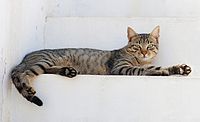
Photo from wikipedia
Current research on gait analysis mostly involves horses and dogs. Feline kinetics and kinematics are being investigated and receiving more clinical interest at present. Ground reaction forces measured on pressure-sensitive… Click to show full abstract
Current research on gait analysis mostly involves horses and dogs. Feline kinetics and kinematics are being investigated and receiving more clinical interest at present. Ground reaction forces measured on pressure-sensitive mattresses have been established in healthy Domestic Shorthair cats (DSH). Currently, no further information exists on either breed-specific measured gait reaction forces or comparisons among breeds. Because Maine Coon (MC) cats appear to be over-represented with orthopaedic diseases of the hind limb (hip dysplasia, patellar luxation), we evaluated ground reaction force GRF measurements in MC cats and compared them with those of DSH cats. Pre-evaluation radiological and clinical exams determined that the cats were not lame. The parameters evaluated were peak vertical force (PFz), vertical impulse (IFz), time to PFz (TPFz), step length (SL), paw contact area (PCA), stance phase duration (SPD) and symmetry index (SI) for the fore- and hind limbs. In both breeds, PFz and IFz were greater in forelimbs than in hind limbs. The PFz and IFz in Newtons were higher in the MC cats compared to the DSH cats, but not after normalisation for total force (%TF) and body mass (%BM). Furthermore, due to their body conformation, MC cats have a longer SL, larger PCA, and higher body weight than DSH cats. No other parameters differed significantly, except that the TPFz displayed an earlier value in the MC hind limbs. Measured symmetry indices were similar to those reported in dogs and did not differ between breeds. This is the first study to report GRF values and temporospatial parameters in a healthy MC cat population. However, our results could not confirm differences between normalized PFz and IFz and temporospatial parameters between the breeds. The authors therefore conclude that genetic or other causes may be involved in orthopaedic hind limb pathogenesis seen in MC cats more often than in other breeds.
Journal Title: PLoS ONE
Year Published: 2018
Link to full text (if available)
Share on Social Media: Sign Up to like & get
recommendations!